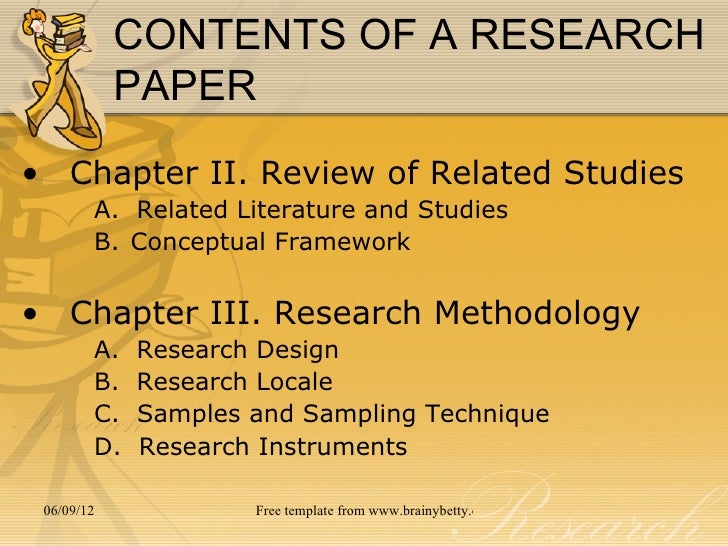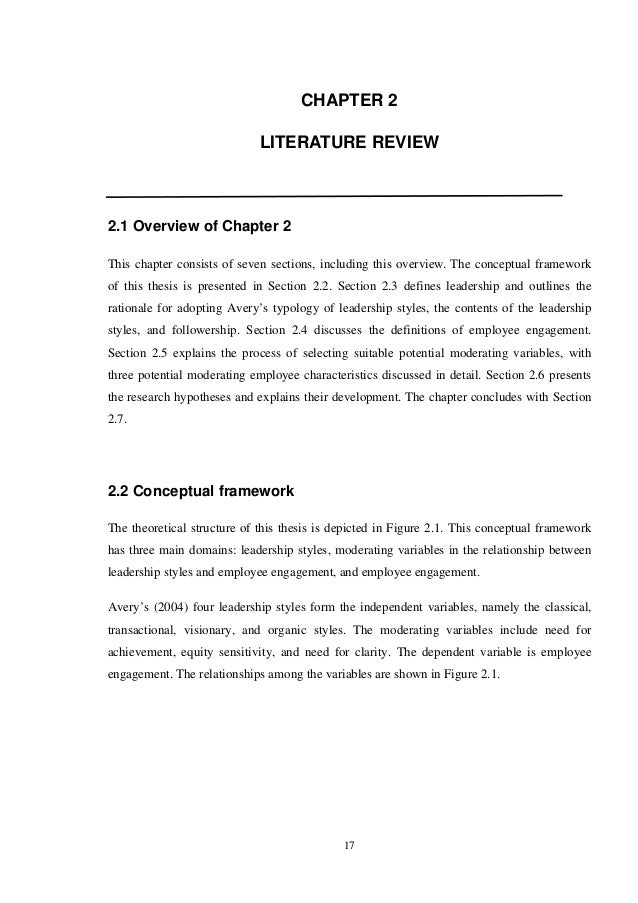
9 CHAPTER 2 REVIEW OF RELATED LITERATURE AND STUDIES This chapter presents the related literature and studies after the thorough and in-depth search done by the researchers. This will also present the synthesis of the art, theoretical and conceptual framework to fully understand the research to be done and lastly the definition of terms for Feb 22, · When you write a dissertation or thesis, you will have to conduct a literature review to situate your research within existing knowledge. The literature review gives you a chance to: Demonstrate your familiarity with the topic and scholarly context; Develop a theoretical framework and methodology for your research A good literature review can ensure that a proper research question has been asked and a proper theoretical framework and/or research methodology have been chosen. In other words, a literature review serves to situate the current study within the body of the relevant literature
How To Write A Literature Review In 3 Steps (Free Template) - Grad Coach
By: Derek Jansen MBA October The literature review chapter of your dissertation or thesis is where you synthesise this prior work and lay the foundation for your own research. So, what exactly is the purpose of the literature review process? There are at least four core functions:. Importantly, you must complete steps one and two before you start writing up your chapter. Instead, you need to read first and distil the information, then plan and execute the writing.
Trust me on this one! While you probably already have a decent base of this from your research proposalyou need to expand on this substantially in the dissertation or thesis itself. So, you need to put on your hunting cap.
Most valuably, it tells you how many times each article has been cited, which gives you an idea of how credible or at least, popular it is. Some articles will be free to access, while others will require an account, which brings us to the next method. Generally, universities provide students with access to an online library, which provides access to many but not all of the major journals. Note that, generally, the search engine capabilities of these databases are poor, so make sure you search for the exact article name, or you might not find it.
You can do this by assessing the citation count of any given article in Google Scholar. If you need help with assessing the credibility of any article, or chapter 2 literature review and theoretical framework finding relevant research in general, you can chat with one of our Research Specialists. See how Grad Coach can help you Book A Free Consultation. This is perfectly natural — through the reading process, your thoughts will developnew avenues might crop up, directional adjustments might arise.
This is, after all, one of the main purposes of the literature review process i. to familiarise yourself with the current state of research in your field. There are three aspects to this:. As you read each article, you should add it to your reference management software. In the beginning, you might feel confident that you can remember who said what, where, and what their main arguments were. If you do a thorough review of the relevant literature as you must! I would suggest using Excel to build your catalogue, as it allows you to run filters, colour code and sort — all very useful when your list grows large which it will.
Most importantly, as you work through the literature and build your catalogue, you need to synthesise all the information in your own mind — how does it all fit together?
Look for links between the various articles and try to develop a bigger picture view of the state of the research. Some important questions to ask yourself are:. To help you develop a big-picture view and synthesise all the information, chapter 2 literature review and theoretical framework might find mind mapping software such as Freemind useful. There are two steps here — outlining and writing:.
Having spent so much time reading, it might be tempting to just start writing up without a clear structure in mind. Your literature review chapter needs to present a clear, logical and an easy to follow narrative — and that requires some planning. The right choice depends on your topic, research objectives and research questions, which we discuss in this article.
Pay particular attention to the flow and narrative — does it fall fit together and flow from one section to another smoothly? The best way to assess this is to ask them to explain the chapter back to you.
This page is an eye opener and easy to comprehend. Thank you for the kind words. All the best writing your literature review. Thank you for a very useful literature review session. Although I am doing most of the steps…it being my first masters an Mphil is a self study and one not sure you are on the right track. I have an amazing supervisor but one also knows they are super busy.
So not wanting to bother on the minutae. Thank you. It is very good video of guidance for writing a research proposal and a dissertation.
Since I have been watching and reading instructions, I have started my research proposal to write. I appreciate to Mr Jansen hugely. Thank you for sharing your knowledge.
As a research student, you learn better with your learning tips in research. I was really stuck in reading and gathering information but after watching these things are cleared thanks, it is so helpful. Excellent information, Clear explanation, and Easy to follow, Many thanks Derek! Your email address will not chapter 2 literature review and theoretical framework published. Save my name, email, and website in this browser for the next time I comment, chapter 2 literature review and theoretical framework.
There are at least four core functions: For you to gain an understanding and demonstrate this understanding of where the research is at currently, what the key arguments, conflicts, etc are.
For you to identify the gap s in the literature and then use this as justification for your research topic. To help you build a theoretical framework for empirical testing if applicable to your research topic. To inform your methodological choices i. see what methods were used in similar studies and help you source tried and tested questionnaires for interviews and measurement instruments for surveys.
Understandingdistilling and organising the literature. Planning and writing up your literature review, chapter 2 literature review and theoretical framework. Method 2 — University Database Scrounging Generally, universities provide students with access to an online library, which provides access to many but not all of the major journals.
Need a helping hand? This will make it easy for you to search for titles with certain words, order research by date, or group by author. Context — Note the socioeconomic context in which the research was undertaken. For chapter 2 literature review and theoretical framework US-based, respondents agedlower- income, etc.
This will be useful for making an argument about gaps in the research. Methodology — Note which methodology was used and why. Also note any issues you feel arise due to the methodology.
Again, you can use this to make an argument about gaps in the research. Quotations — Note down any quoteworthy lines you feel might be useful later, chapter 2 literature review and theoretical framework. Notes — Make notes about anything not already covered. For example, linkages to or disagreements with other theories, questions raised but unanswered, shortcomings or limitations, and so forth. Some important questions to ask yourself are: What answers does the existing research provide to my own research questions?
Which points do the researchers agree and disagree on? How has the research developed over time? Where do the gaps in the current research lie? Step 3: Outline and write it up! There are two steps here — outlining and writing: 3. Then, tighten it up and send it off to your supervisor for comment.
Make sure you understand the 4 core functions of the process. The first step is to hunt down the relevant literature. You can do this using Google Scholar, your university database, chapter 2 literature review and theoretical framework, the snowballing technique and by reviewing other dissertations and theses. Next, chapter 2 literature review and theoretical framework, you need to log all the articles in your reference managerbuild your own catalogue of literature and synthesise all the research.
Following that, you need to develop a detailed outline of your entire chapter — the more detail the better. Remember, done beats perfect. Then tighten it up and submit to your supervisor. Phindile Mpetshwa on November 17, at pm. Thank you very much. Yinka on June 24, at am. This is awesome! I wish I come across GradCoach earlier enough. Thank you for this good job. Keep it up! Derek Jansen on July 8, at am. Renee Buerger on August 2, at am. Derek Jansen on August 12, chapter 2 literature review and theoretical framework, at pm, chapter 2 literature review and theoretical framework.
Good luck with your literature review �� Reply. Sheemal Prasad on September 9, at am. This has been really helpful. Will make full use of it.
How to Write a Literature Review in 30 Minutes or Less
, time: 17:12Literature review - Wikipedia

Oct 01, · Recap: How to write a literature review. In this article, we’ve covered how to research and write up a winning literature review chapter. Let’s do a quick recap of the key points: It essential to understand the WHY of the literature review, before you read or write anything. Make sure you understand the 4 core functions of the process A literature review is a written document that presents a logically argued case founded on a comprehensive understanding of the current state of knowledge about a topic of study. This case establishes a convincing thesis to answer the study’s question. (p. 4) Despite this complexity, most research methodology textbooks only devote at most one The theoretical and conceptual framework explains the path of a research and grounds it firmly in theoretical constructs. The overall aim of the two frameworks is to make research findings more

No comments:
Post a Comment